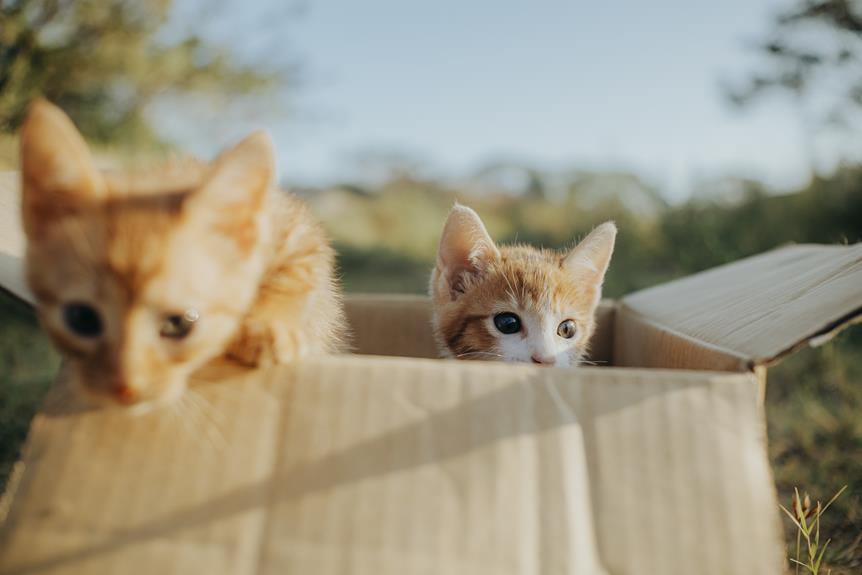When the summer temperatures soar, cats become experts in the art of cat-astic cooling. From panting to seeking out cool surfaces, your kitty has multiple ways to beat the heat. But do you know the signs of overheating, how to prevent it, and how to address it?

Unlock the secrets of cats’ cooling mechanisms and learn the best ways to keep your kitty cool and comfortable during hot weather. With your help, your cat can be the coolest of the cool this summer!
Table of Contents
How Cats Cool Down: Key Takeaways
- Cats have various natural cooling mechanisms, such as sweating through their paw pads and seeking out shady or cool spots.
- It is important to provide access to fresh and cold water for cats, especially during hot weather, and to change the water frequently throughout the day.
- Managing a cat’s coat during summer is crucial, including regular brushing and considering professional hair clipping in hot areas.
- Creating cool spots for cats and using ice and damp towels can help them cool down and stay comfortable during hot weather.
Cats’ Cooling Mechanisms
You may be surprised to learn that cats have several cooling mechanisms to help them regulate their body temperature.
Cats have sweat glands on their footpads and throughout their skin, but they’re less active than in humans. Panting in cats is usually a sign of overheating, stress, or an underlying health issue.
Cats instinctively seek cool spots, like under a bush or on a tile floor, and will bathe themselves to cool down.
More serious symptoms of heat exhaustion/heat stroke include dark red or grayish gums, vocalization, vomiting or diarrhea, and trembling.
It’s important to take advice for cats in summer and offer them plenty of water and cool spots to stay comfortable.
Signs of Overheating in Cats
You can recognize signs of overheating in cats, such as panting, sweaty paws, and lethargy, as well as more serious symptoms, like dark red or grayish gums and trembling.
Cats attempt to cool themselves by sweating through their paw pads, grooming, and seeking out cooler surfaces and shade.
Heat stroke is a life-threatening condition, and it’s important to monitor cats for signs of overheating and immediately provide them with fresh, cool water and ice cubes.
If their symptoms persist, contact a veterinarian right away.
Cats need access to fresh water and cool spaces in order to prevent overheating.
Being attentive to your cat’s body temperature is essential for their health and wellbeing.
Preventing Overheating in Cats
You can take steps to prevent your cat from overheating, such as providing frequent water breaks and using cooling mats and fans in their carrier. Cats have several ways of cooling themselves, but panting isn’t one of them. If your cat is panting, it’s a sign of heat exhaustion or stress.
You can also open windows and turn on the air conditioning to help cool them off. During outdoor adventures, make sure to take frequent breaks in shaded areas and offer your cat plenty of water. When the weather is especially hot, it’s better to adventure in the mornings or evenings when temperatures are lower.
Heat exhaustion shouldn’t be taken lightly as it can be fatal to cats. Be sure to keep an eye on your cat and be prepared to stop and take a break if they start to show signs of overheating.
Identifying and Addressing Overheating in Cats
Identifying when your cat is overheating and taking steps to address it are key to helping them stay cool. Cats can’t sweat like humans, so they rely on more subtle cooling methods like conduction, grooming, and fur to regulate their temperature. However, when cats are in hot weather or stressful situations, they can still become overheated.
Signs of overheating in cats include panting, sweaty paws, lethargy, drooling, and excessive grooming. More serious symptoms of heat exhaustion/heat stroke include dark red or grayish gums, vocalization, vomiting or diarrhea, trembling, confusion, and dizziness.
To prevent overheating, make sure your cat is hydrated, take frequent breaks during outdoor adventures, and use a cooling mat and/or battery-powered travel fan in their carrier. If any of these symptoms occur, find a cool, shaded spot and offer them water.
Cats rely on us to keep them cool in the summer, so make sure your cool cat doesn’t overheat.
Additional Tips for Keeping Cats Cool
With these additional tips, you can ensure your cat stays cool and comfortable on hot summer days.
Make sure your cat has some sun protection and shade, as cats prefer to stay away from direct sunlight.
Keep food and water bowls in a cool area of the home and always make sure they’re filled with fresh, cold water.
Be sure to also provide your cat with cool treats such as ice cubes, tuna brine, or chicken broth.
It’s also important to keep your cat safe in the home and avoid leaving them in cars or any other enclosed, hot spaces.
Finally, groom your cat regularly to help their body regulate heat.
With these pet advice tips, you can keep your cat cool and happy.
Frequently Asked Questions
What Temperature Should a Cat’s Internal Body Temperature Be Maintained At?
Cats need to maintain an internal body temperature of 101°F to 102°F. Ensure your cat is comfortable and healthy by monitoring their temperature. Provide them with plenty of water and cool, shaded spots to keep them cool.
Is It Safe to Shave a Cat During the Summer Months?
Shaving a cat during summer months is like taking away their life jacket – it can be dangerous. Cats rely on their fur to protect against the heat. Clipping fur can disrupt their natural cooling process and increase the risk of heat exhaustion. Seek professional advice if you’re considering it.
How Do Cats Use Conduction to Cool Down?
You can help your cat stay cool by understanding how they use conduction. Cats seek out cooler objects, such as kitchen tiles, to touch and regulate their internal body temperature. Doing this helps them maintain their body temp and avoid overheating.
Is Panting in Cats Always a Sign of Overheating?
No, panting in cats isn’t always a sign of overheating – it can be a sign of stress or an underlying health issue. Monitor your cat closely and seek professional help if you suspect something is wrong. Help your furry friend stay safe and cool!
What Type of Treats Can Be Offered to Cats to Help Keep Them Hydrated?
Offer cats high-water content treats, such as tuna brine or chicken broth, to help keep them hydrated. Be sure the treats are served in a bowl or container to avoid a strong smell. Cooling their paws with ice cubes can also help keep them cool.
My name is Ben and I am a cat lover. I’m not a professional writer or a doctor or an expert of any kind on anything. But I am a guy who likes to share what little knowledge and experience I have with others.
